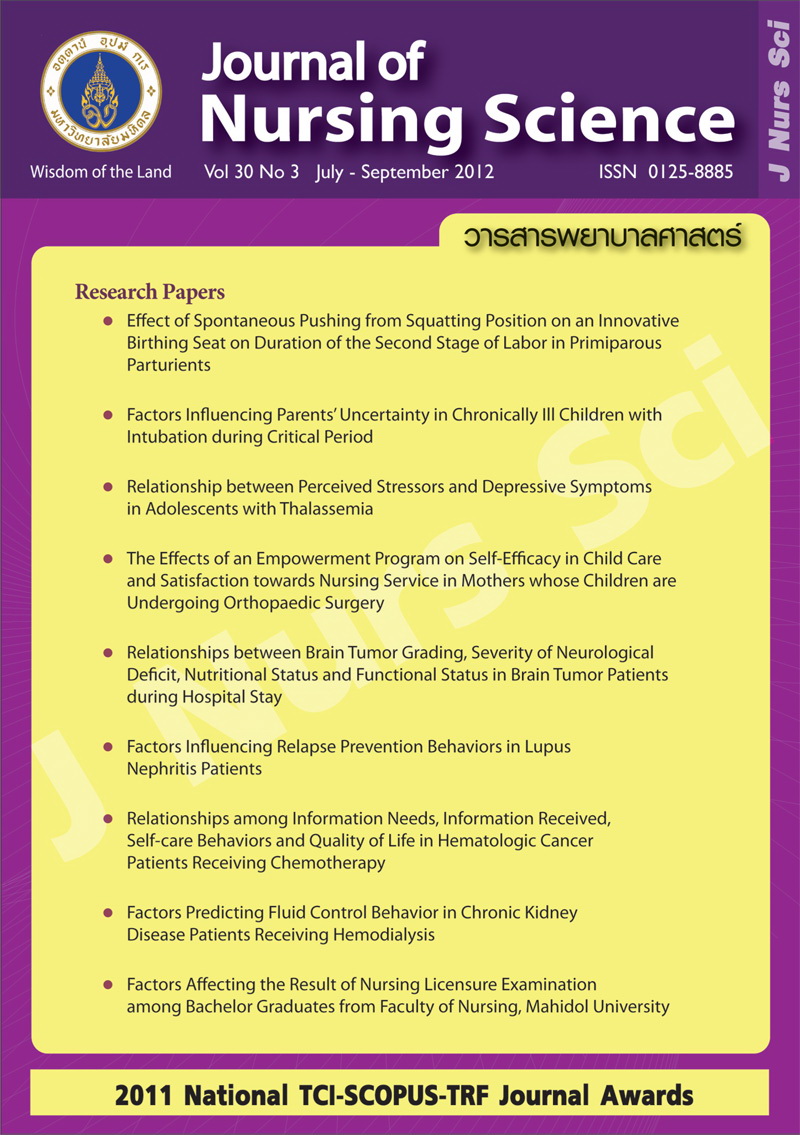Effect of Spontaneous Pushing from Squatting Position on an Innovative Birthing Seat on Duration of the Second Stage of Labor in Primiparous Parturients
Main Article Content
Abstract
Purpose: This research aimed to compare the effect of spontaneous pushing from squatting position on an innovative birthing seat with controlled pushing from supine position on duration of the second stage of labor in primiparous parturients.
Designs: Quasi-experimental design.
Methods: Through convenience sampling, 60 primiparous parturients at labor unit, Taksin Hospital were divided into a control and an experimental group with 30 each. The control group gave birth by controlled pushing from supine position while the experimental group spontaneous pushing from squatting position on the innovative birthing seat. Data collection instruments consisted of demographic data and birth data records. Data were analyzed using descriptive statistics and independent t-test.
Main findings: The findings of the study revealed that duration of the second stage of labor in the experimental group was less than that in the control group with statistical significance (p < .05).
Conclusion and recommendations: This study showed that spontaneous pushing from squatting position on the birthing seat could reduce the duration of the second stage of labor. Therefore, nurse midwives should apply this method of pushing with the innovative birthing seat in their nursing care to assist parturients during the second stage of labor.
บทคัดย่อ
วัตถุประสงค์: เพื่อศึกษาเปรียบเทียบผลของวิธีการเบ่งคลอดแบบธรรมชาติ ร่วมกับท่านั่งยองบนนวัตกรรมเบาะนั่งรองคลอด กับวิธีการเบ่งคลอดแบบควบคุมร่วมกับท่านอนหงาย ต่อเวลาในระยะที่ 2 ของการคลอดในผู้คลอดครรภ์แรก
รูปแบบการวิจัย: การวิจัยแบบกึ่งทดลอง
วิธีดำเนินการวิจัย: กลุ่มตัวอย่างจำนวน 60 ราย เป็นผู้คลอดที่มาคลอดบุตรคนแรกที่ห้องคลอด โรงพยาบาลตากสิน คัดเลือกกลุ่มตัวอย่างตามเกณฑ์ที่กำหนด แบ่งกลุ่มตัวอย่างเป็นกลุ่มควบคุม 30 ราย ที่ใช้วิธีการเบ่งคลอดแบบควบคุมร่วมกับท่านอนหงาย และกลุ่มทดลอง 30 ราย ที่ใช้วิธีการเบ่งคลอดแบบธรรมชาติร่วมกับท่านั่งยองบนเบาะนั่งรองคลอด เครื่องมือที่ใช้ในการเก็บข้อมูล ได้แก่ แบบบันทึกข้อมูลทั่วไป และแบบบันทึกข้อมูลเกี่ยวกับการคลอด วิเคราะห์ข้อมูลโดยใช้สถิติเชิงพรรณนาและสถิติการทดสอบที
ผลการวิจัย: ผลการศึกษาพบว่า กลุ่มที่ใช้วิธีการเบ่งคลอดแบบธรรมชาติร่วมกับท่านั่งยอง มีเวลาในระยะที่ 2 ของการคลอด น้อยกว่ากลุ่มที่ใช้วิธีการเบ่งคลอดแบบควบคุม ร่วมกับท่านอนหงายอย่างมีนัยสำคัญทางสถิติ (p < .05)
สรุปและข้อเสนอแนะ: ข้อสรุปจากการศึกษาในครั้งนี้แสดงให้เห็นว่า การให้ผู้คลอดใช้วิธีการเบ่งคลอดแบบธรรมชาติร่วมกับท่านั่งยองบนนวัตกรรมเบาะนั่งรองคลอด สามารถลดเวลาในระยะที่ 2 ของการคลอดได้ ซึ่งพยาบาลผดุงครรภ์ควรนำวิธีการเบ่งคลอดร่วมกับนวัตกรรมเบาะรองนั่งดังกล่าวมาประยุกต์ในการปฏิบัติพยาบาลเพื่อดูแลผู้คลอดในระยะที่ 2 ของการคลอด
คำสำคัญ: เบาะนั่งรองคลอด ผู้คลอดครรภ์แรก ระยะที่ 2 ของการคลอด การเบ่งคลอดแบบธรรมชาติ ท่านั่งยอง
Article Details
Copyright Notice: Nursing Science Journal of Thailand has exclusive rights to publish and distribute the manuscript and all contents therein. Without the journal’s permission, the dissemination of the manuscript in another journal or online, and the reproduction of the manuscript for non-educational purpose are prohibited.

Disclaimer: The opinion expressed and figures provided in this journal, NSJT, are the sole responsibility of the authors. The editorial board bears no responsibility in this regard.

